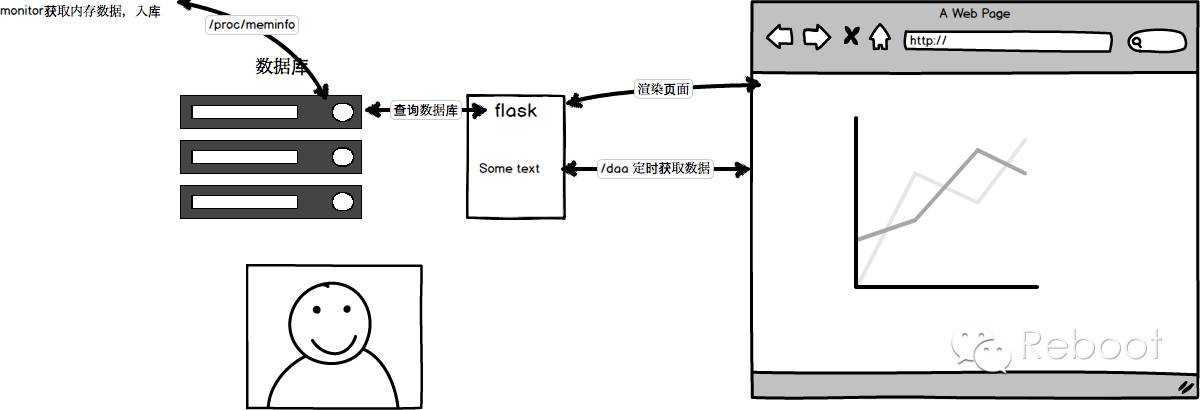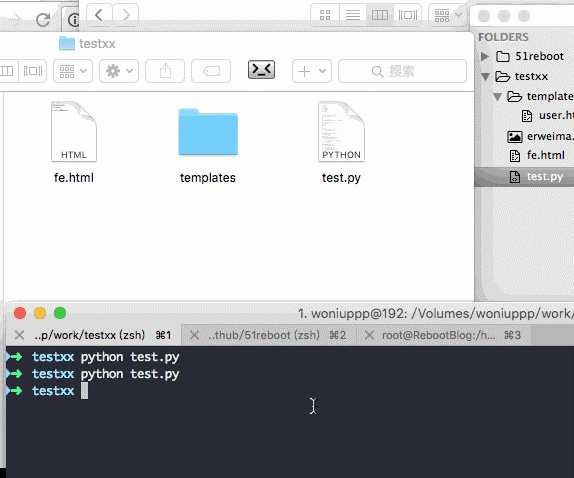本文的目的在于,尽可能用简单的代码,让大家了解内存监控的原理,及思想。更容易去理解Nagios、Zabbix、Ganglia监控原理,文章最后还有视频教程链接哦,从零敲出来的全过程
思路分为下面几块:
1.获取内存监控信息
2.存储监控信息
3.数据展现
4.后续扩展
1.加主机名,monitor部署在多台机器,不直接插入数据库
2. 增加CPU,Disk监控
3. 通过HTTP请求的方式,启用一个单独的Flask专门存储monitor数据

第一步:获取内存信息
我们通过读取 /proc/meminfo获取监控数据MemTotal、MemFree、Buffers、Cached,咱们常用free -m 其实也是读取的/pro/meminfo的数据,顺便说一下
对于操作系统来说,Buffers、Cached是已经被使用的
MemFree=total-used
对于应用程序来说
MemFree=buffers+cached+free
监控物理内存使用
内存使用=MemTotal-MemFree-Buffers-Cached
开撸:monitor.py获取监控数据
def getMem(): with open(‘/proc/meminfo‘) as f: total = int(f.readline().split()[1]) free = int(f.readline().split()[1]) buffers = int(f.readline().split()[1]) cache = int(f.readline().split()[1]) mem_use = total-free-buffers-cache print mem_use/1024 while True: time.sleep(1) getMem()
测试:每秒打印一条数据
[[email protected] memory]$ python mointor.py 2920 2919 2919 2919 2919
希望内存多变好一些,写了一个很挫的测试代码
# test.py s = ‘www.51reboot.com‘*1000000 for i in s: for j in s: s.count(j)
执行python test.py,会发现内存占用多了几M,说明咱们的代码是OK的
第二步:存储监控信息(我们用mysql)
我们需要两个字段,内存和时间 sql呼之欲出,简单粗暴
create database memory;
create memory(memory int,time int)
接下来我们把monitor.py的数据存储到数据库中,这用到了Python MySQLdb模块
import time import MySQLdb as mysql db = mysql.connect(user="reboot",passwd="reboot123",db="memory",host="localhost") db.autocommit(True) cur = db.cursor() def getMem(): with open(‘/proc/meminfo‘) as f: total = int(f.readline().split()[1]) free = int(f.readline().split()[1]) buffers = int(f.readline().split()[1]) cache = int(f.readline().split()[1]) mem_use = total-free-buffers-cache t = int(time.time()) sql = ‘insert into memory (memory,time) value (%s,%s)‘%(mem_use/1024,t) cur.execute(sql) print mem_use/1024 while True: time.sleep(1) getMem()
暂时告一段落
第三步:数据展现(Flask框架)
代码结构
├── flask_web.py web后端代码
├── mointor.py 监控数据获取
├── static 静态文件,第三方图表库
│ ├── exporting.js
│ ├── highstock.js
│ └── jquery.js
├── templates
│ └── index.html 展示前端页面
└── test.py 占用内存的测试代码

from flask import Flask,render_template,request import MySQLdb as mysql con = mysql.connect(user=‘reboot‘,passwd=‘reboot123‘,host=‘localhost‘,db=‘memory‘) con.autocommit(True) cur = con.cursor() app = Flask(__name__) import json @app.route(‘/‘) def index(): return render_template(‘index.html‘) @app.route(‘/data‘) def data(): sql = ‘select * from memory‘ cur.execute(sql) arr = [] for i in cur.fetchall(): arr.append([i[1]*1000,i[0]]) return json.dumps(arr) if __name__==‘__main__‘: app.run(host=‘0.0.0.0‘,port=9092,debug=True)
前端index.html
<div id="container" style="height: 400px; min-width: 310px"></div> <script> $(function () { // 使用当前时区,否则东八区会差八个小时 Highcharts.setOptions({ global: { useUTC: false } }); $.getJSON(‘/data‘, function (data) { // Create the chart $(‘#container‘).highcharts(‘StockChart‘, { rangeSelector : { selected : 1 }, title : { text : ‘内存数据‘ }, series : [{ name : ‘本机内存‘, data : data, tooltip: { valueDecimals: 2 } }] }); }); }); </script>
执行python flask_web.py,浏览器看数据www.51reboot.com:9092,出图了

我们并不仅限于此,如果想实时的看到内存,应该怎么搞
1.查询数据时候增加一个时间戳当限制条件,只返回两次查询之间的增量数据
2.前端动态添加增量结点数据到图表中
修改flask_web.py
tmp_time = 0 @app.route(‘/data‘) def data(): global tmp_time if tmp_time>0: sql = ‘select * from memory where time>%s‘ % (tmp_time/1000) else: sql = ‘select * from memory‘ cur.execute(sql) arr = [] for i in cur.fetchall(): arr.append([i[1]*1000,i[0]]) if len(arr)>0: tmp_time = arr[-1][0] return json.dumps(arr)
前端,3秒查一次增量数据,根据自己需求调整,修改index.html
$.getJSON(‘/data‘, function (data) { // Create the chart $(‘#container‘).highcharts(‘StockChart‘, { chart:{ events:{ load:function(){ var series = this.series[0] setInterval(function(){ $.getJSON(‘/data‘,function(res){ $.each(res,function(i,v){ series.addPoint(v) }) }) },3000) } } }, rangeSelector : { selected : 1 }, title : { text : ‘AAPL Stock Price‘ }, series : [{ name : ‘AAPL‘, data : data, tooltip: { valueDecimals: 2 } }] }); });
done!两个文件都搞定,double kill! 效果

后边改了这么多,大家可能糊涂了,现在给出完整代码:
完整代码大家可以从Github下载
https://github.com/shengxinjing/my_blog/issues/1
视频下载地址:http://pan.baidu.com/s/1i4acpP7
Python学习交流群:238757010